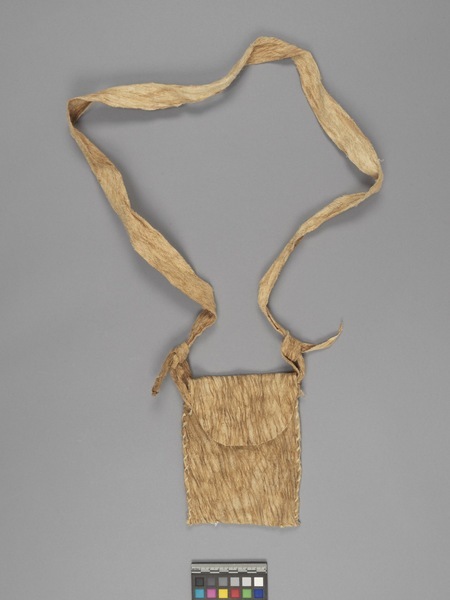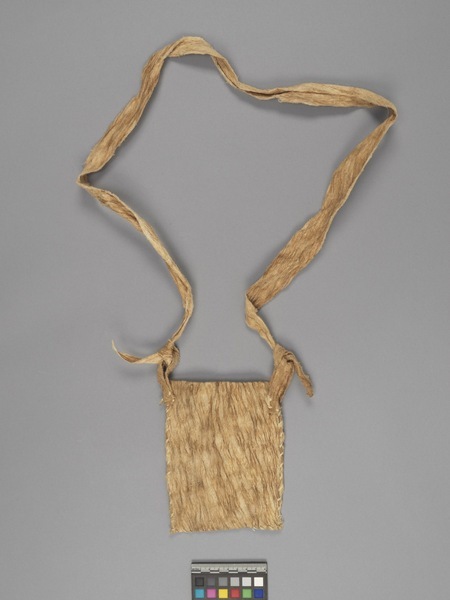Bag Item Number: 3289/92 from the MOA: University of British Columbia


Description
Small barkcloth bag. Composed of a single rectangular piece of cloth, folded, and then loop-stitched along both sides. A small rounded flap hangs over the open end. A long barkcloth strap is attached to loops on either side of the bag.
History Of Use
These bags are made from various species of fig tree that grow in the Lacandon forest. Strips of bark are soaked in water and then pounded to form this thin extended bark textile. This kind of small bark cloth item is sold outside the Palenque archaeological site to tourists. The bags are for casual use, e.g., they might be worn or used during rituals, but they are not a ritual object.
Narrative
The Lacandon rainforest stretches through the Southern Mexican states of Chiapas and Yuacatan, as well as the northern part of Guatemala and is one of the most biodiverse regions of Central America. This jungle is home to communities of Maya speakers known as the Lacandon Maya, who support themselves through “agro-forestry”, a system built on sustainable crop rotation. The Lacandon forest contains over 1,500 tree species and is one of the last forested areas large enough to support jaguars, an animal sacred to the contemporary Lacandon, as well as to ancient Maya peoples. The Lacandones used to live near ancient Maya archaeological sites such as Bonampak and Yaxchilan. Many have now migrated to Palenque, which is more accessible to, and popular among, tourists. The Lacandon peoples are no longer permitted to use archaeological sites for ritual purposes. However, Lacandon ceremonies, centred around agricultural petitions, offerings and spir-itual healing continue to take place in the forest, conducted by ritual specialists. Specialists tradi-tionally wear bark cloth tunics for these ceremonies. The artist and her husband (now deceased) are originally from the jungle but have lived for some time in Palenque.
Item History
- Made by Margarita Nuc (Maker) in Chiapas, Mexico between 2000 and 2017
- Collected by Laura Osorio between 2017 and 2018
- Owned by Laura Osorio before April 11, 2018
- Received from Laura Osorio (Seller), Museum of Anthropology Exhibitions Budget (Funding source) and Michael O'Brian Family Foundation (Funding source) on April 11, 2018
What
- Name
- Bag
- Identification Number
- 3289/92
- Type of Item
- bag
- Material
- fig bark, plant fibre and fibre
- Overall
- height 43.0 cm, width 25.0 cm
Who
- Culture
- Maya: Lacandon
- Creator
- Margarita Nuc (Maker)
- Field Collector
- Laura Osorio
- Previous Owner
- Laura Osorio
- Received from
- Laura Osorio (Seller), Museum of Anthropology Exhibitions Budget (Funding source) and Michael O'Brian Family Foundation (Funding source)
Where
- Holding Institution
- MOA: University of British Columbia
- Made in
- Chiapas, Mexico
When
- Creation Date
- between 2000 and 2017
- Collection Date
- between 2017 and 2018
- Ownership Date
- before April 11, 2018
- Acquisition Date
- on April 11, 2018
Other
- Condition
- good
- Accession Number
- 3289/0092